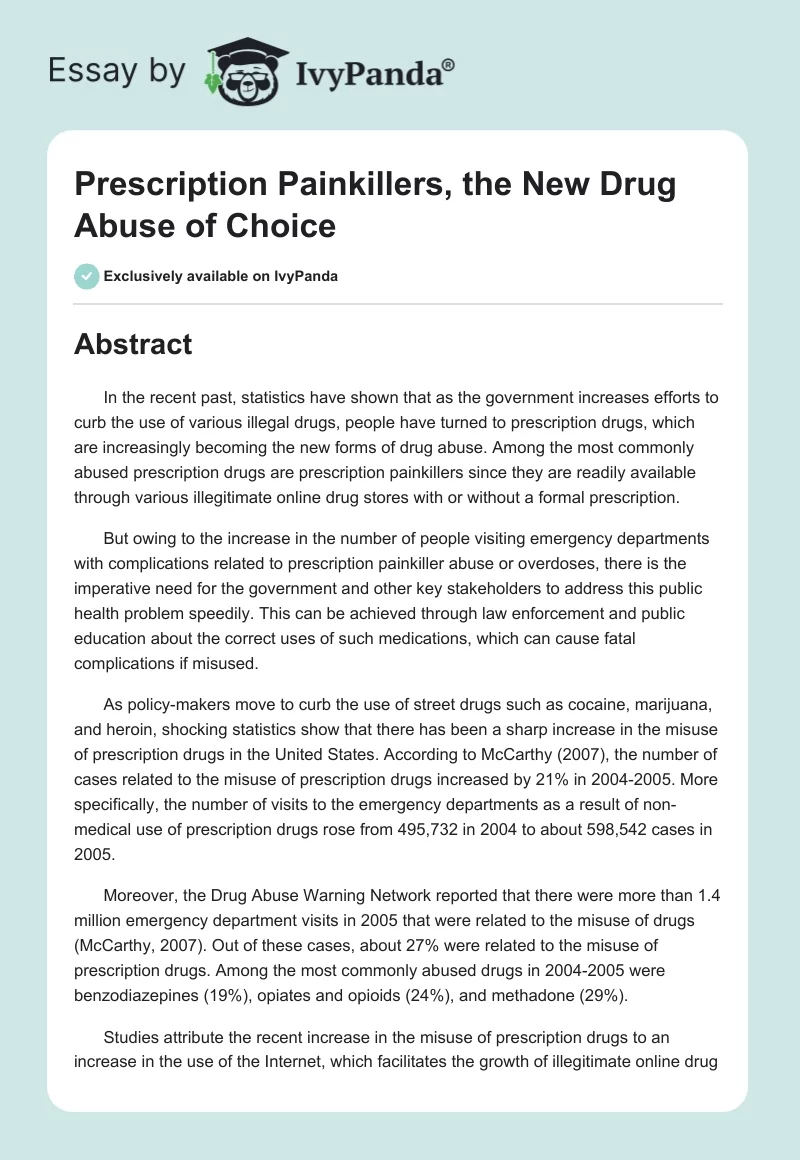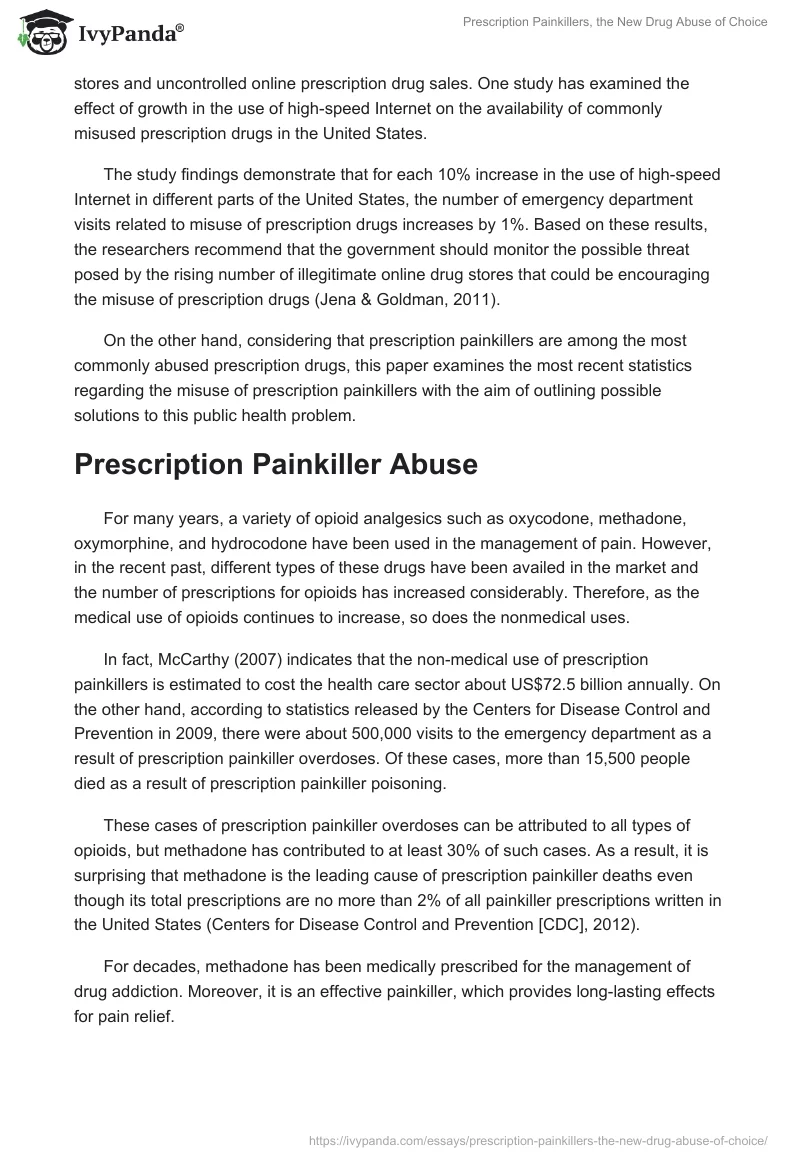Abstract
In the recent past, statistics have shown that as the government increases efforts to curb the use of various illegal drugs, people have turned to prescription drugs, which are increasingly becoming the new forms of drug abuse. Among the most commonly abused prescription drugs are prescription painkillers since they are readily available through various illegitimate online drug stores with or without a formal prescription.
But owing to the increase in the number of people visiting emergency departments with complications related to prescription painkiller abuse or overdoses, there is the imperative need for the government and other key stakeholders to address this public health problem speedily. This can be achieved through law enforcement and public education about the correct uses of such medications, which can cause fatal complications if misused.
As policy-makers move to curb the use of street drugs such as cocaine, marijuana, and heroin, shocking statistics show that there has been a sharp increase in the misuse of prescription drugs in the United States. According to McCarthy (2007), the number of cases related to the misuse of prescription drugs increased by 21% in 2004-2005. More specifically, the number of visits to the emergency departments as a result of non-medical use of prescription drugs rose from 495,732 in 2004 to about 598,542 cases in 2005.
Moreover, the Drug Abuse Warning Network reported that there were more than 1.4 million emergency department visits in 2005 that were related to the misuse of drugs (McCarthy, 2007). Out of these cases, about 27% were related to the misuse of prescription drugs. Among the most commonly abused drugs in 2004-2005 were benzodiazepines (19%), opiates and opioids (24%), and methadone (29%).
Studies attribute the recent increase in the misuse of prescription drugs to an increase in the use of the Internet, which facilitates the growth of illegitimate online drug stores and uncontrolled online prescription drug sales. One study has examined the effect of growth in the use of high-speed Internet on the availability of commonly misused prescription drugs in the United States.
The study findings demonstrate that for each 10% increase in the use of high-speed Internet in different parts of the United States, the number of emergency department visits related to misuse of prescription drugs increases by 1%. Based on these results, the researchers recommend that the government should monitor the possible threat posed by the rising number of illegitimate online drug stores that could be encouraging the misuse of prescription drugs (Jena & Goldman, 2011).
On the other hand, considering that prescription painkillers are among the most commonly abused prescription drugs, this paper examines the most recent statistics regarding the misuse of prescription painkillers with the aim of outlining possible solutions to this public health problem.
Prescription Painkiller Abuse
For many years, a variety of opioid analgesics such as oxycodone, methadone, oxymorphine, and hydrocodone have been used in the management of pain. However, in the recent past, different types of these drugs have been availed in the market and the number of prescriptions for opioids has increased considerably. Therefore, as the medical use of opioids continues to increase, so does the nonmedical uses.
In fact, McCarthy (2007) indicates that the non-medical use of prescription painkillers is estimated to cost the health care sector about US$72.5 billion annually. On the other hand, according to statistics released by the Centers for Disease Control and Prevention in 2009, there were about 500,000 visits to the emergency department as a result of prescription painkiller overdoses. Of these cases, more than 15,500 people died as a result of prescription painkiller poisoning.
These cases of prescription painkiller overdoses can be attributed to all types of opioids, but methadone has contributed to at least 30% of such cases. As a result, it is surprising that methadone is the leading cause of prescription painkiller deaths even though its total prescriptions are no more than 2% of all painkiller prescriptions written in the United States (Centers for Disease Control and Prevention [CDC], 2012).
For decades, methadone has been medically prescribed for the management of drug addiction. Moreover, it is an effective painkiller, which provides long-lasting effects for pain relief.
However, it is imperative to note that as the medical uses of methadone increase, so does the nonmedical uses owing to its widespread availability in most pharmacies and online drug stores. Shockingly, studies by the US Food and Drug Administration (FDA) have warned against the indiscriminate use of methadone owing to several risks associated with the drug.
The major risks associated with methadone include increased toxicity at low doses, drug build up that can cause slowed breathing, and disruption of the heart’s rhythm. Nonetheless, different pharmacies across the United States received more than four million prescriptions for this drug in 2009.
Moreover, methadone is readily available to many people considering that it is a low-cost generic drug recommended by many physicians and insurance companies. However, the major problem with this drug is that many cases of methadone-related deaths involve people who purchase the drug without a formal prescription. Accordingly, studies indicate that most people obtain methadone using illegal prescriptions or through other means such as drug diversion (CDC, 2012).
Recommendations
From the foregoing discussions, it is evident that the risk of prescription painkiller abuse has increased considerably in the last decade. This has been attributed to an increase in the availability of prescription painkillers through illegitimate online drug stores and other illegal means such as drug diversion.
As a result, there is the immediate need for the United States government to engage other stakeholders in ensuring that federal laws prohibiting the non-medical use and possession of prescription painkillers are enforced to the letter. On the other hand, health care providers should ensure that they follow the correct guidelines that govern the use of different prescription painkillers including methadone.
Moreover, health care providers should design proper prescription drug monitoring systems in order to ensure that their patients do not misuse prescription painkillers (CDC, 2012). Overall, a close collaboration between the government, healthcare providers, and health insurance providers can go a long way in terms of preventing or reducing prescription drug abuse and overdoses.
References
Centers for Disease Control and Prevention [CDC]. (2012). Prescription painkiller overdoses: Use and abuse of methadone as a painkiller. Web.
Jena, A. B., & Goldman, D. P. (2011). Growing Internet use may help explain the rise in prescription drug abuse in the United States. Health Affairs, 30(6), 1192-1199.
McCarthy, M. (2007). Prescription drug abuse up sharply in the USA. The Lancet, 369(9572), 1505-1506.


